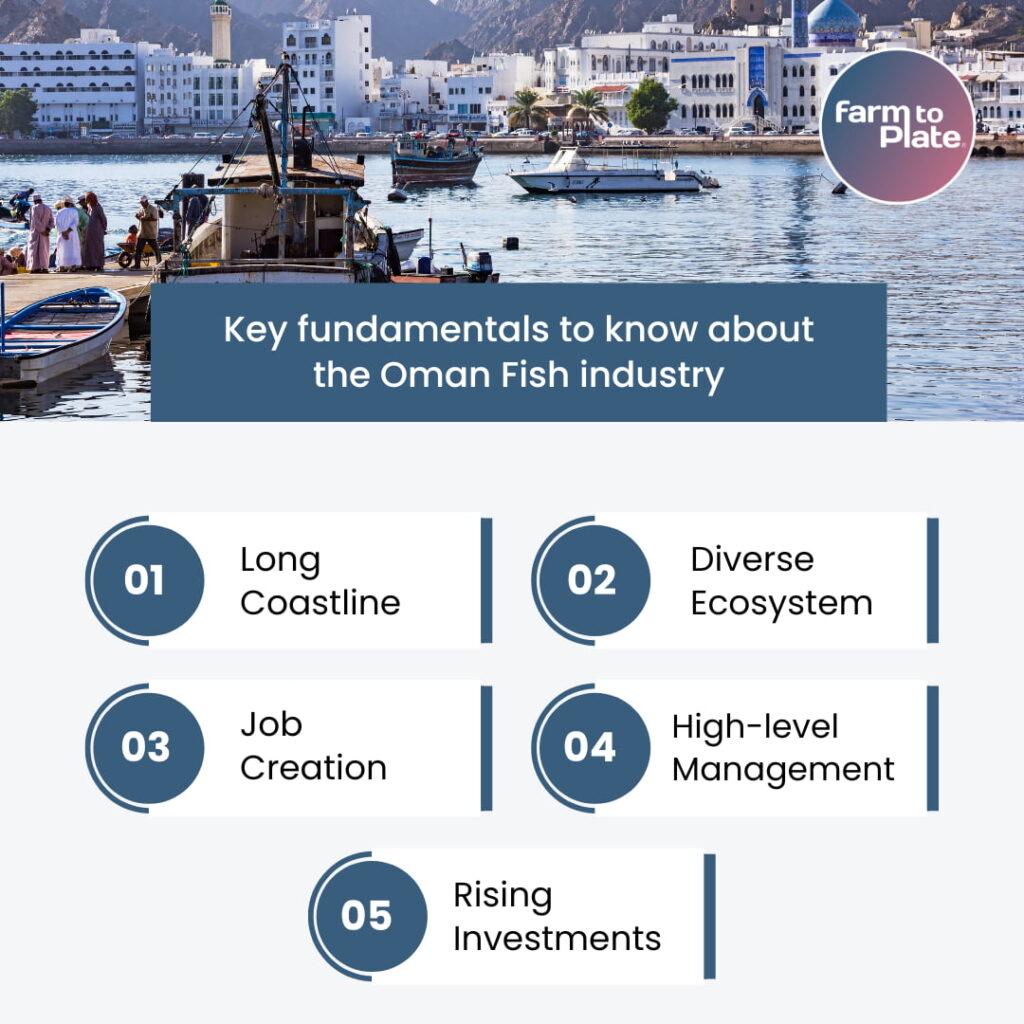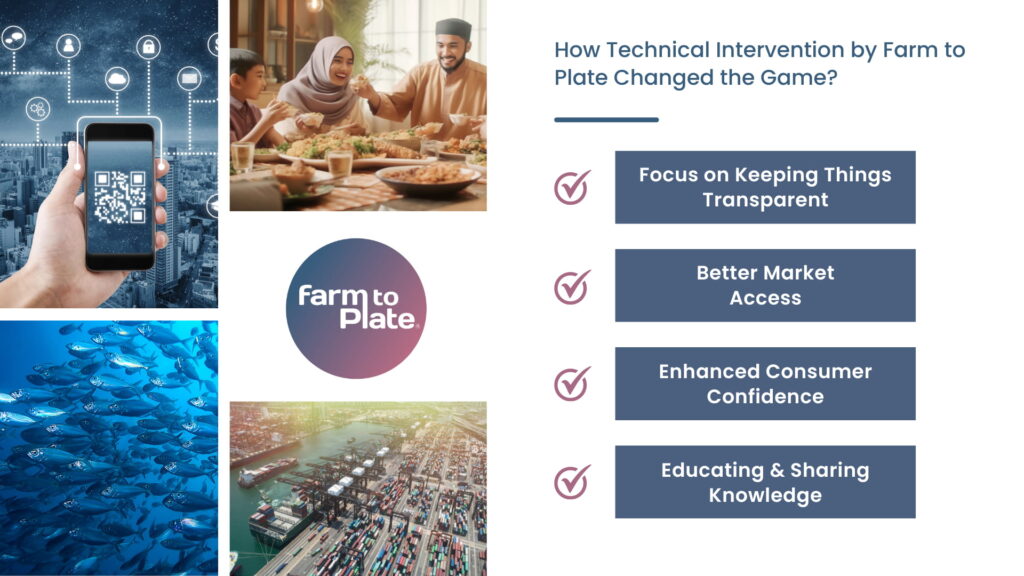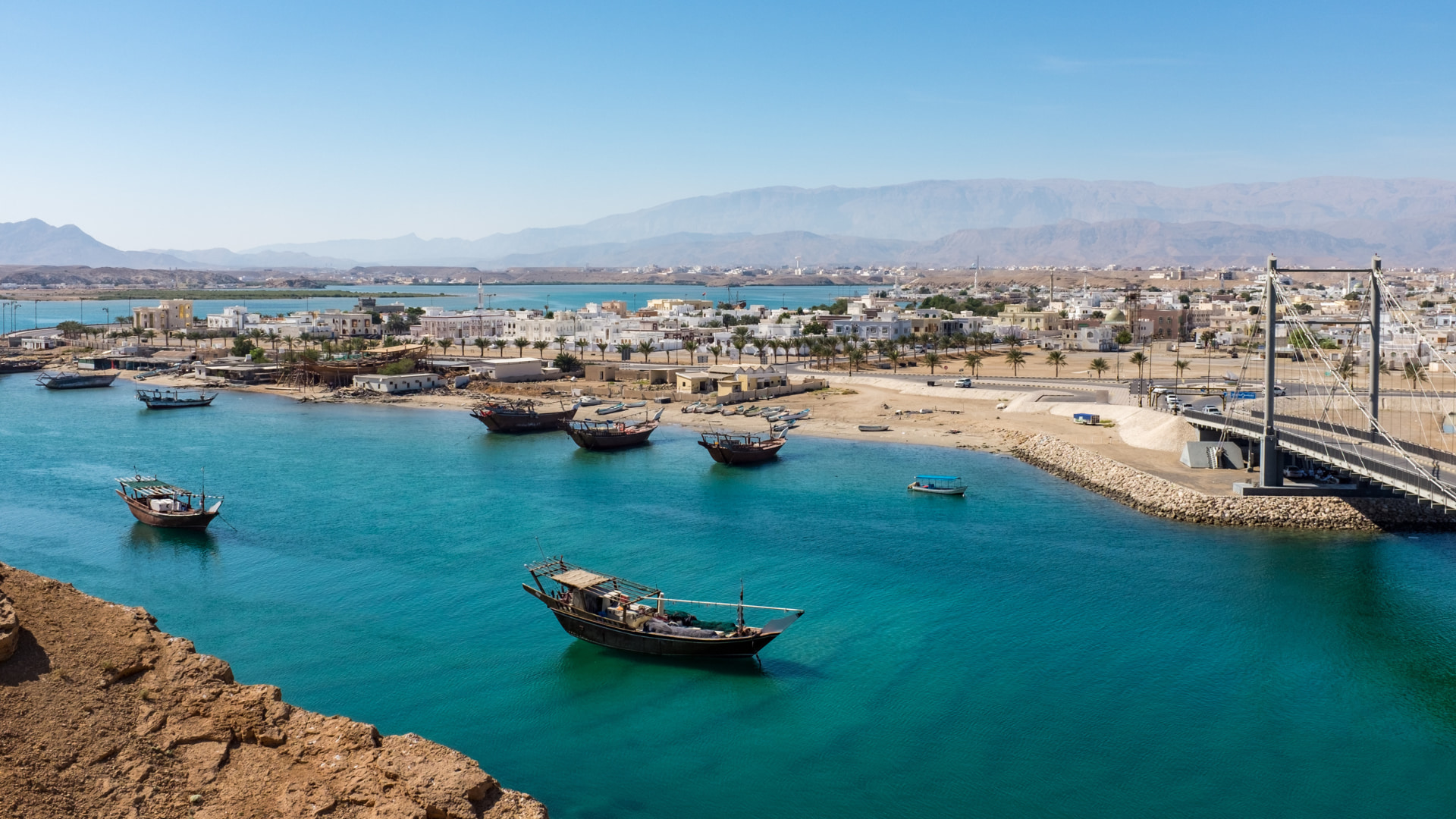Oman’s rich fish industry has a significant impact on its economy and cultural heritage. Situated in the heart of Muttrah, Oman’s fish industry demonstrates the profound relationship between its people and the sea. As per a report, the fish industry in Oman stands nearly at USD 640M, and it is projected to reach beyond USD 850M by the end of 2029.
As a sector deeply rooted in tradition, the fish industry is now embracing modern technologies that are transforming its operations, management, and market reach. In this article, we will explore how these advancements are fostering sustainability, transparency, and economic growth in Oman’s fish industry.
Fundamentals about the Oman Fish Industry:

Here are some of the key fundamentals to know about the Oman Fish industry:
- Long Coastline: Oman’s coastline stretches over 3,165 kilometers, providing extensive and productive fishing grounds.
- Diverse Ecosystem: The diverse marine ecosystem supports a wide variety of fish species, making the fishing industry a cornerstone of the national economy.
- Job Creation: In 2022 alone, Oman produced over 580,000 metric tons of fish, illustrating the industry’s significant output. This robust production not only supplies local markets but also supports thousands of jobs, thereby contributing to the livelihoods of many Omanis.
- High-level Management: The sector’s ability to sustain such a high level of production is partly due to the responsible management and technological innovations being implemented.
- Rising Investments: The country has experienced a significant rise in the monetary benefits that the aquatic industry gives them after they adapted to modern-day techniques.
Oman’s Fishing Industry Getting A Tech Boost
Oman’s fishing industry is benefiting from a rising adoption of new-age technologies. For instance, the technical advancements and initiatives by Farm to Plate are proving to be game changers for the Oman fish industry. Here’s how:
1. Advanced Tracking Methods
One of the critical advancements in this domain is the adoption of advanced tracking technologies. GPS and Internet of Things (IoT) devices are now widely used to monitor fishing vessels in real time.
2. Ensuring Sustainability
These technologies play a crucial role in ensuring sustainable fishing practices. As you get precise data on the location and movement of fishing fleets, these tracking systems help in the management of fish stocks.
Moreover, Farm To Plate’s technology stack helps in preventing overfishing and ensures that fishing activities comply with regulations. It becomes easier to keep an eye on and ensure everything happens as per the set guidelines.
3. Improving Productivity
The real-time data collected also aids in the efficient coordination of fishing efforts. If adapted in an efficient manner, the technical inputs help in enhancing productivity and reducing waste.
How Technical Intervention by Farm to Plate Changed the Game

1. Focus on Keeping Things Transparent
Transparency is the key to success in not only the fish industry but any other domain for that matter. One such aspect is Blockchain technology, which has revolutionized the way the fish industry operates. It introduced unparalleled levels of transparency as each fish can now be traced from the sea to the plate.
Every vendor can now document every step of its journey. This traceability is further enhanced by QR codes that provide consumers with detailed information about the fish’s origin, journey, and handling processes.
By simply scanning these codes, consumers can access data on the species, the location where the fish got caught, and the fishing method used. Moreover, they can even get to know about the vessel that caught the fish. The transparency helps build trust, and it also empowers consumers to make informed choices, promoting sustainable consumption patterns.
2. Better Market Access
Another technical advancement is the increasing number of online marketplaces. It has extended market access and has made both selling and buying fish extremely convenient.
The rise of online marketplaces has opened up new avenues for Omani fishermen to connect with global buyers. These digital platforms streamline the export processes, making it easier and more efficient for fishermen to access international markets.
By reducing the barriers to entry, online marketplaces drive economic growth and market expansion for the fish industry. Moreover, it offers a platform for small-scale fishermen, giving them a chance to compete on a global stage. This way, they can make their products reach a broader audience. This increased market access will boost the income of fishermen. Moreover, it will strengthen the overall economy by promoting trade and investment.
3. Enhanced Consumer Confidence
One of the primary reasons to introduce technology is to gain consumer trust. It is a critical factor in the success of the fish industry, as the confidence that the consumer shows in the industry is directly proportional to the market growth.
The traceability systems supported by blockchain technology and QR codes are instrumental in building this confidence. Certifications and eco-labels further enhance the credibility of the industry by showcasing adherence to sustainable practices. These certifications, often backed by rigorous standards, assure consumers that the fish they purchase is sourced responsibly.
The consumer can do his own research and gain confidence about the authenticity as well! The visibility of these certifications and the ability to trace the fish’s journey foster a sense of trust and reliability. As a result, consumers are more likely to choose Omani fish, knowing that it meets high standards of sustainability and quality.
4. Educating & Sharing Knowledge
Another area where technology can make a big difference is the dissemination of knowledge and best practices. Different technical platforms that are synonymous with the agricultural industry facilitate in sharing of knowledge among fishermen through mobile apps and online forums.
These platforms enable fishermen to exchange information on sustainable practices, innovative fishing techniques, and quality improvement measures. By fostering a community of learning and collaboration, these AgriTech solutions are helping fishermen enhance their skills and adapt to modern challenges. This collective knowledge helps improve the quality of the catch; also it ensures that fishing practices remain sustainable and environmentally friendly.
Conclusion
Oman’s fish industry is a testament to how tradition and modern technology can coexist and complement each other. The integration of advanced tracking systems, blockchain technology, and online marketplaces is transforming the industry, making it more sustainable, transparent, and economically viable.
These innovations are not only preserving the rich cultural heritage of Oman’s fishing practices but are also paving the way for a prosperous future. As the industry continues to evolve, it stands as a model for how technological advancements can drive growth and sustainability in traditional sectors.
Farm to Plate is doing its bit to focus on sustainability and healthy yield. You can join the wagon too, by making smart choices and only inclining towards sustainable options whenever possible.
Tanya A Mishra, Technical Content Writer & Marketer at farmtoplate.io (specialising in MENA Tech Landscape). She has been working towards crafting insightful content on topics like Blockchain, Agritech, AI and many more.
